Vijayanta (1965)

 Main Battle Tanks - 2,200 built 1965-86.
Main Battle Tanks - 2,200 built 1965-86.
The first Indian MBT
Years after the independence, tensions with Pakistan were high enough to trigger several border disputes. The first in 1947 degenerated in a full scale war about the Jammu and Kashmir area. The second started in 1965, Pakistan launching Operation Gibraltar to infiltrate forces into Jammu and Kashmir. By that time, the bulk of the Indian armoured force comprised Centurion MBTs, which performed relatively well. But there was already in the 1950s the will to built a purely Indian main battle tank, with local industrial resources. Even before the war of 1965, it was decided to built an existing model under licence, but as the same time with requirements for a lighter model than the Centurion.Derived from the Vickers Mk.I
As a private venture Vickers-Armstrong decided to built a model solely for export and has developed the Mark.I, a 24-tonne 20-pdr gunned tank design largely equipped with Centurion components. Later this main gun was swapped for the new and far more effective L7 105 mm gun. As this development coincided with an agreement with India in 1961 for a lighter tank design, Vickers Armstrong also agreed to built a factory in India for this purpose. The final Vickers MBT Mk 1 was simple, low-cost and effective, retaining the same firepower as the Centurion, and which was also sold to Kuwait (70). The prototype was tried in India, and the production approved. In India this licence-built model was named Vijayanta ("Victorious"). The first tanks rolled out of the line in 1964 and entered service in 1965, just when the war broke out.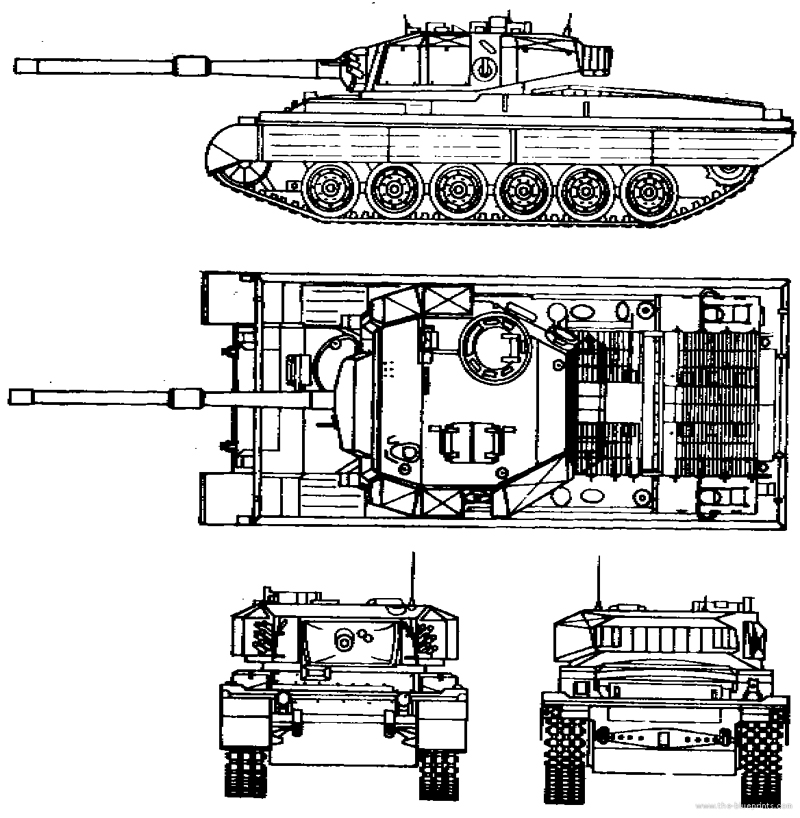
vijayanta Mark.1 4-view recoignition drawing
Design of the Vijayanta
Since the latter was largely based on the Mark I with few adaptations, the Vijayanta was built the same way, of welded rolled homogeneous armour plates, and weighted 38 short tons. It was more or less equivalent to the soviet-built T-54/55 at the time, but this did\'nt make it a light tank either. The armour was seriously reduced compared to the centurion, with only 80 mm on the turret and glacis front plate. Still, this was good enough against conventional ww2-era tanks or early coldwar models like the Pakistani M47/M48 Pattons equipped with a 90 mm gun. Furthermore, the L7 gave them the necessary "reach" to kill before even going into range. The placement of the turret, 1/3 to the front, and the large rear engine compartment make it similar in silhouette to the centurion. Both tanks had also roughly the same size and shared many components, which was a factor for its adoption, since maintenance and supply could be common with the Centurions in service.The drivetrain comprised six roadwheels and three return rollers, but these roadwheels were not grouped into three pairs of bogies but heavenly spaced and narrower from each others, all with their independent torsion bars. The drivetrain was generally lower, as the silhouette. From the beginning, steel side skirts made of seven panels were added. The turret was of the same design that of the Centurion, but smaller, with a commander cupola with eight bullet-proof glass vision blocks to the right, and a simple two-piece hatch for the gunner to the left. Five storage boxes took place to the sides, three on the left and two on the right, with an escape hatch in between. There were fastening hooks for additional canvas bags and equipments, including spare roadwheels, and a rear turret basket. Both the gunner and commander had daytime periscope with magnification. Soon, two banks of electrically fired smoke grenade launchers (six each) were positioned on either side of the main gun mantlet. There was also a medium-range radio with two whip antennae on the turret.
vijayanta Mark.1 preserved at Port blair
The armament comprised the L7, and later L7A2 main gun, with 44 rounds in storage between the turret and hull sides and floor. Secondary armament comprised a coaxial 12.7 mm ranging heavy machine gun with 2000 rounds in store, a second one, optional, on the roof\'s pintle mount and a thord one, 7.7 mm LMG also positioned coaxially to the main gun, with 500 rounds in store. The main gun could fire HEAT, frag, and HE rounds. Ranging gun procedures were similar to thoses developed in UK with the Centurion and Chieftain, for the latter as a backup.
Evolution, from the Mark 1 to the Mark 2
The whole fleet of vijayantas, the figure of around 2200 tanks is often given, but according to Jane's Armour and Artillery 2003-2004 between 1800 to 1600 at the lowest, perhaps explained by the different versions and variants. In this case armoued 400 tanks or more would have been either specialized variants (see later) and/or upgrades like the Mk.1A,B,C and Mark 2.- Marconi upgrade: 70 Vijayanta Mark 1 tanks were fitted with Marconi\'s SFCS 600 fire control system
- "Bison" upgrades. 1100 Mark I were planned but apparently only a small numbers were so converted.
- Kanchan advanced composite armour upgrade (From the Arjun tank)
- Engine upgrade: With the V-84 of 780 hp of the T-72
- New SUV-T55A fire control system, modern land navigation system.
- Mark 1A: Bharat Electronics Tank Fire-Control System AL 4420, improved sight mounts & muzzle reference system.
- Mark 1B: AL 4421 system, with a computer-assisted Barr & Stroud Tank Laser Sight to increase first round hit probability.
- Mark 1C and Vijayanta Mark 2 were the latest upgrades.
Specialized variants
Catapult SPA
A Russian M-46 field gun was mounted on a lengthened Vijayanta hull in an open-topped armoured box superstructure.Kartik AVLB
Used the the same lengthened hull for a bridge launching vehicle, using a scissors style bridge of Eastern European design. First introduced in 1989.Vijayanta ARV
The design of this Armoured recovery vehicle, based on the standard Mark I hull, was lightened and optimized to keep the weight below 40 tons, for a lifting capacity of 10 tons, and pulling capacity of 25 tons. Around 200 converted, replacing older models.CEASE
For "Canal Embankment ASsault Equipment", a special type of bridging system developed by Engineers of the Research & Development Establishment (R&DE) at Pune. Designed for bank canals up to 4.5 m met on the Indian western borders with Pakistan. In April 1989 it was approved and six tracked vehicles were developed. Now obsolete and replaced by DRDO Sarvatra bridge system.Vijayanta GBT 155 SPG
Standard chassis equipped with a British GBT 155 turret mounting a Royal Ordnance Nottingham cal 39 ordnance. Thoroughly tested but not adopted for service by the Indian Army.vijayanta Mark.1 preserved at the National War Memorial(Maharashtra), Pune
The Vijayanta in action
The vijayanta came into service too late for the 1965 war and the lessons of the conflict could not have been applied. However in constant exercises it proved up to the expectations of the general staff in terms of speed and mobility, and the same gunnery standards were achieved due to the experience gained on the Centurion. However their first battle test occurred in the war of 1971, also called the Bangladesh Liberation War, over the issue of Kashmir. Indian armoured divisions, now largely equipped with the vijayanta, intervened to support the Bangladesh liberation movement, and saw intense fightings until the surrender of the Eastern Pakistan forces. Lieutenant General Jagjit Singh Aurora, heading the 8th, 28th, and 57th divisions, led the Indian thrust into East Pakistan, using "blitzkrieg" tactics, exploiting weakness in the enemy\'s positions and bypassing opposition, while making huge numbers of prisoners.The Indo-Pakistani War of 1999, also called "Kargil War" saw limited action for the tanks due to the mountainous nature of the terrain, it was followed by a de-mobilization of the older models still in service. It was decided in the 1990s to have the whole Mk.1 fleet entirely phased out of service by 2008. 296 "pre-Mark 1A" were already gradually retired in 1997 and the same year the plan of upgrading and re-engineering the Vijayanta was approved. This overhaul was discontinued from 1999-2000 to the planned withdrawal in 2008. Spares parts production already ended in 1989. However the problems which occurred with the development of the Arjun MBT resulted in the adoption of licence-built Ajeya (T-72M) instead to replace the whole fleet.
Links about the Vijayanta/Vickers Mk.I BMT
vijayanta MBTAdditional informations on bharat-rakshak.com
Vijayanta specifications |
|
| Dimensions (l-w-h): | 6.15 oa x 2.42 x 2.24 m (20.2 x 7.1 x 7.4 in) |
| Total weight, battle ready: | 43 short tons/39 tonnes (xxx ibs) |
| Crew : | 4 (Driver, gunner, Commander, loader) |
| Propulsion: | Leyland L60 Diesel 535 bhp (399 kW) |
| Transmission: | David Brown Ltd. TN12 semi auto. gearbox |
| Suspensions: | Torsion bars |
| Top Speed (flat) | 50 kph(31 mph) |
| Range (road) | 530 km (330 mi) |
| Armament | 105 mm L7A2 with 44 rounds (5 in) 2 x 12.7 mm (0.5 in) HMG, 1 x 7.7 mm (0.3 in) coaxial |
| Armour | Maximum 80 mm (3.1 in) glacis front, turret front. |
| Total Production | 2200 |
References gallery
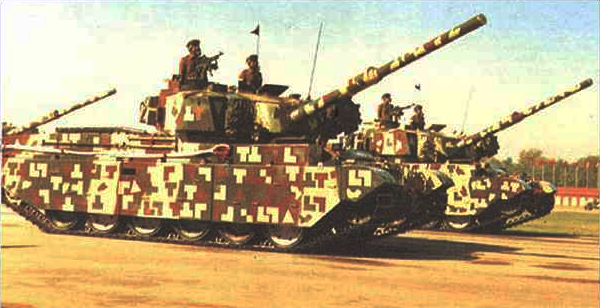
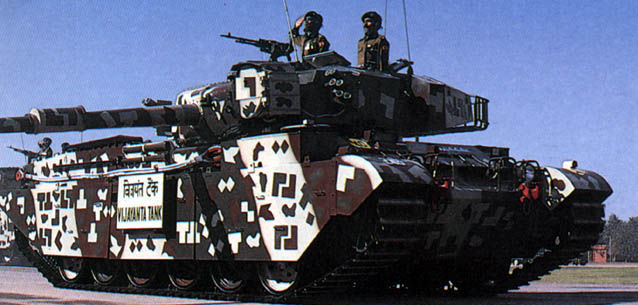
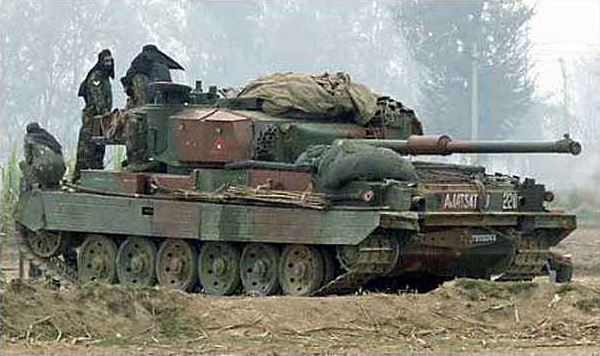
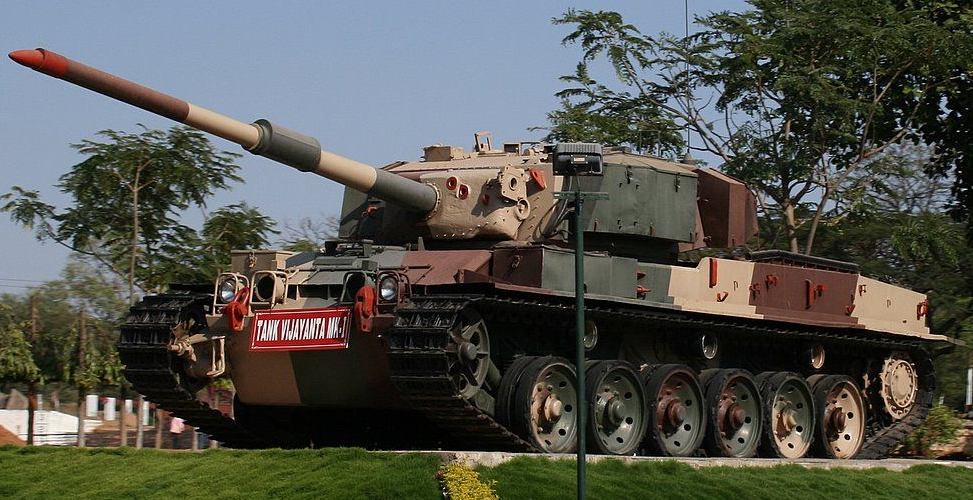
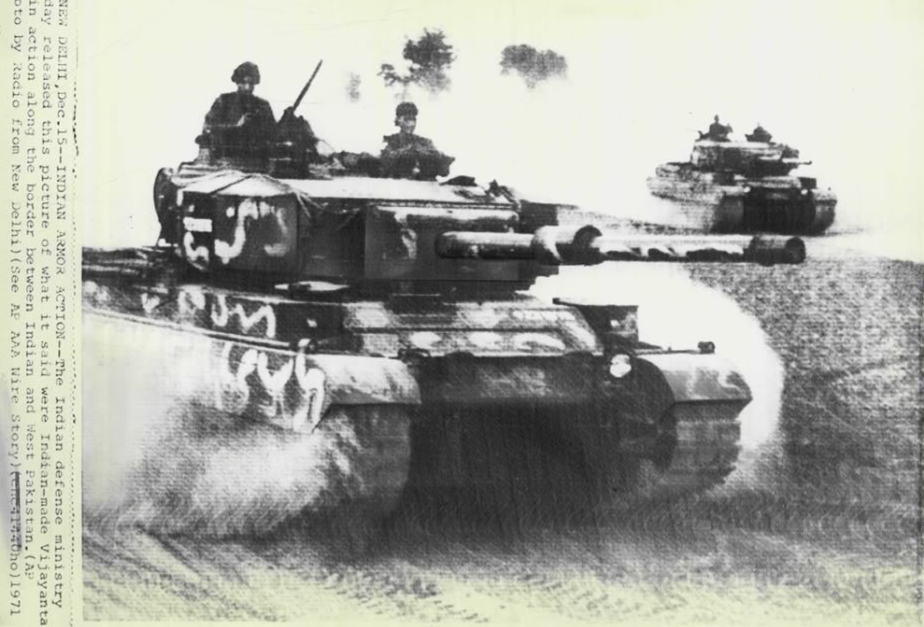
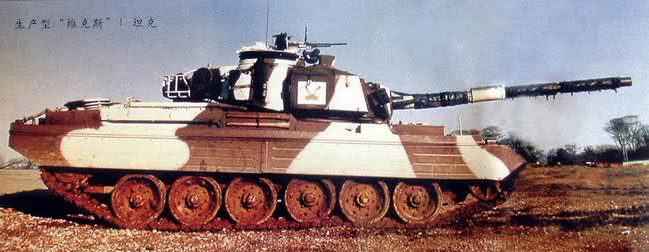

Preserved Mk.I, now at Port Blair on static display. Another in a similar early green livery is on display at the Indian National War Memorial (Maharashtra).

vijayanta I in operations on the Indian-Pakistani border during the war in 1971, as stated by the text. The improvized camouflage seemed to have been made by brooms with washable paint, either white or beige.

Vijayanta Mark one in the 1980s standard camouflage. A variant added dark brown to this pattern.

Vijayanta Mark 1A, now on display without side skirts.

Vijayanta Mk.1B or Mk1C in operations, 1980s.

Possibly a Mark 2, 1990.

Cold War Tanks


































Cold war tanks posters

Cold War Main Battle Tanks

Cold War Soviet Army
Museums, Movies, Books & Games
The Tanks and Armor in pop culture
Tanks and armored vehicles in general are only really grasped when seen first person: The mass, the scale, it's all there. Explore also the way tanks were covered in the movie industry, in books and in video games.Movies:
Best tanks movie on warhistoryonline.com
On imdb.com
On bestsimilar.com/
miltours.com
liveabout.com/
watchmojo.com
Video Games:
pcgamesn.com
historyhit.com
levvvel.com
vg247.com/best-tank-games
mmobomb.com/
alienwarearena.com
